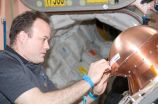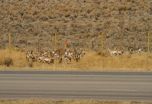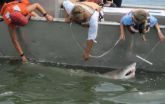HOUSTON, TX, October 18, 2012 (Press-News.org) When an aerospace engineer says breaking up is hard to do, they are not referring to matters of the heart. Instead, they are looking at best practices for the breakup of large items returning from space to Earth. Understanding what happens during this process is the goal of the ReEntry Breakup Recorder, or REBR. This device hitched a ride on the European Space Agency's Automated Transfer Vehicle-3, or ATV-3, as it departed the International Space Station and re-entered Earth's atmosphere on Oct 2, 2012.
A better grasp of large item breakups could help economize deorbit efforts by aiding engineers as they develop best practices for efficient and safe decommissioning. For some vehicles, such as the Russian Soyuz, this is not a problem -- they are designed to survive re-entry. One-time-use vehicles, however, have any remaining debris targeted for a harmless ocean splashdown. This is where REBR comes in. Think of it as a space vehicle "black box" in a copper shell that can help researchers to find out exactly what happens during re-entry.
In a recent interview, William Ailor, Ph.D. and principal investigator for REBR, spoke of the goals for this study. "What we'd like to know is at what altitude do things come apart? What is the heating? There's some evidence that models, at least prior to this time, have over predicted heating at higher altitudes, which means that you would predict that less survives than actually does," said Ailor. "So one of our objectives with this REBR experiment is to get some definitive data on how objects respond as they re-enter the atmosphere."
The space station crew attaches the REBR hardware to a re-entering vehicle prior to undocking. REBR then records real-time data from the point where the vehicle first senses the atmosphere to splashdown, as the unmanned cargo vessel burns up around it. After the host vehicle breaks apart and REBR releases, REBR makes something similar to a cell phone call to transmit data to a ground computer prior to impact.
The suite of sensors inside of REBR includes the following: a GPS receiver, temperature sensors, accelerometers and rate gyros, a pressure sensor, various electronics, an Iridium modem, a combination GPS/Iridium antenna, and batteries. The exterior shape of the device follows specifications developed by NASA's Langley Research Center that make the device self-stabilizing after release from its copper shell. NASA's Ames Research Center provided preliminary designs for the REBR heat shield and conducted wind tunnel tests to verify subsonic stability--important for successful transmission of recorded data.
Previous REBR experiments provided data when the Japan Aerospace Exploration Agency's H-II Transfer Vehicle, or HTV-2, and HTV-3 re-entered the atmosphere, with both vehicles breaking up over the Pacific Ocean. ATV-2 also included REBR hardware, but did not transfer information back. The cause of that data loss is thought to be an explosion of ATV-2 before REBR released from the vehicle.
There is also a safety element associated when large items return from space. "I would say the general rule of thumb is anything that weighs more than 800 kg is something that we would be concerned about, but it depends on what the components of the object are made of and their size and mass, as well," said Ailor. "Experience tells us that anywhere from 10% to 40% of an object's dry mass on orbit will survive to hit the ground, so that means that you have to have an object of sufficient size that has big enough surviving fragments to be a hazard."
Researchers hope to simplify re-entry trajectories for launch vehicles and satellites with their findings, as well as to engineer crafts to come apart in controlled ways -- what they call "design for demise." Experts can use the REBR data to design space hardware that is more predictable and safer when it re-enters. The knowledge gained from understanding how vehicles behave during atmospheric re-entry also means a more cost-effective spacecraft.
"One of the ways for removing space debris from orbit, or removing it as a long-term concern, is to re-enter it into the atmosphere," said Ailor. "There are basically two ways to re-enter things, one is to do it like we are doing it with the ATV-3, which is direct into the ocean, but that can be expensive for somebody who is operating a spacecraft. So if we can lower the hazard sufficiently for these large objects, they could be allowed to re-enter randomly and that reduces the cost substantially for spacecraft operators."
Another way engineers can improve vehicles is to ensure they disintegrate into less hazardous fragments, based on their design. Some may even be eligible for natural decay in orbit. This would mean the item could re-enter without the expensive propellants and operations associated with a controlled deorbit, reducing costs and prolonging the life of the vehicle.
REBR data will contribute to survivability models, as well, which help determine risk assessments and strategies for re-entry. This goes back to the design for demise, which can improve future exploration vehicle engineering, as well as protect people from breakups here on Earth -- though when it comes to breakups of the heart, humans are still on their own.
For the latest news about research being done on the International Space Station, please visit:
http://www.nasa.gov/mission_pages/station/research/news.html
For more information on past, ongoing, and future ISS research activities, including research results and publications, please visit:
http://www.nasa.gov/mission_pages/station/research/index.html
If you are interested in subscribing to updates from the ISS Program Science Office, please visit:
https://lists.nasa.gov/mailman/listinfo/iss-program-science-group
For more information about the International Space Station, visit:
http://www.nasa.gov/station
For information about NASA and agency programs, visit:
http://www.nasa.gov
The Science of Breaking Up Via Space Station Re-Entry Investigation
RELEASE: JR12-016
2012-10-18
ELSE PRESS RELEASES FROM THIS DATE:
Almost 80% Believe Free Wi-Fi Can Lead to Identity Theft, Study Finds
2012-10-18
A new study of 377 Americans highlights the growing concern of using public Wi-Fi Hotspots. The survey, conducted by the Identity Theft Resource Center (ITRC) in conjunction with PRIVATE WiFi, revealed that 79% of respondents believe that using a free Wi-Fi connection can lead to identity theft. 45% of respondents said they were concerned about their security when using a public hotspot and 15% indicated that they were "very concerned." 44% of respondents weren't aware that there is a way to protect their sensitive information while using a public hotspot.
In ...
Children with ADHD find medication frees them to choose between right and wrong, study suggests
2012-10-17
Children living with attention deficit hyperactivity disorder (ADHD) tend to feel that they benefit from medication to treat the condition and do not feel that the medication turns them into 'robots', according to a report published today. In fact, they report feeling that medication helps them to control their behaviour and make better decisions. The study, which gives a voice to the children themselves, provides valuable insights into their experiences and the stigma they face.
The ADHD VOICES – Voices on Identity, Childhood, Ethics and Stimulants – study has worked ...
Where the deer and the antelope cross
2012-10-17
The locations of the structures completed this fall were informed by data collected by WCS, the Wyoming Cooperative Fish and Wildlife Research Unit, and the Wyoming Game and Fish Department, and identified the pronghorn's preferred migration routes and highway crossing points.
WCS has long studied an approximately 93-mile (150 km) migration of pronghorn between wintering grounds in the Upper Green River Basin and summering grounds in Grand Teton National Park (GTNP)—a migration corridor known as the "Path of the Pronghorn." WCS worked with many partners including ...
New insights into how genetic differences influence breast cancer risk from low-dose radiation
2012-10-17
Scientists from the U.S. Department of Energy's Lawrence Berkeley National Laboratory (Berkeley Lab) have identified tissue mechanisms that may influence a woman's susceptibility or resistance to breast cancer after exposure to low-dose ionizing radiation, such as the levels used in full-body CT scans and radiotherapy.
The research could lead to new ways to identify women who have higher or lower risks of breast cancer from low-dose radiation. Such a predictive tool could help guide the treatment of cancer patients who may be better served by non-radiation therapies.
The ...
Overcoming memories that trigger cocaine relapse
2012-10-17
Researchers from the University of Wisconsin-Milwaukee (UWM) have identified mechanisms in the brain responsible for regulating cocaine-seeking behavior, providing an avenue for drug development that could greatly reduce the high relapse rate in cocaine addiction.
The research reveals that stimulation of certain brain receptors promotes inhibition of cocaine-associated memories, helping addicts to stop drug use. This inhibition is achieved through enhancing a process called "extinction learning," in which cocaine-associated memories are replaced with associations that ...
Shark social networking
2012-10-17
University of Delaware researchers are using an underwater robot to find and follow sand tiger sharks that they previously tagged with transmitters. The innovative project is part of a multi-year partnership with Delaware State University to better understand the behavior and migration patterns of the sharks in real time.
"In the past week our new, specially equipped glider OTIS – which stands for Oceanographic Telemetry Identification Sensor – detected multiple sand tiger sharks off the coast of Maryland that were tagged over the past several years," said Matthew Oliver, ...
Fresh out of high school, 2 Chicago students present research at AAPS Annual Meeting
2012-10-17
Arlington, Va. — Two Chicago high school students have developed a novel treatment method to reduce the negative effects of Fetal Alcohol Syndrome (FAS) and a new understanding of genetics behind the disease. This research is being presented at the 2012 American Association of Pharmaceutical Scientists (AAPS) Annual Meeting and Exposition in Chicago, Ill., Oct. 14 – 18. More than 8,000 attendees are expected at the largest conference dedicated to the pharmaceutical sciences.
Ayana Jamal and Ariella Hoffman-Peterson, 2012 graduates of Niles North High School in Skokie, ...
Prolonged formula feeding, delay in solid foods associated with increased risk for pediatric ALL
2012-10-17
This abstract will be presented at a press conference hosted by program chairperson Cory Abate-Shen, Ph.D., the Michael and Stella Chernow professor of urological oncology and associate director of the Herbert Irving Comprehensive Cancer Center at Columbia University Medical Center, in the San Simeon AB Room on the fourth floor of the Hilton Anaheim at 7:30 a.m. PT on Wednesday, Oct. 17. Reporters who cannot attend in person can call in using the following information:
U.S./Canada (toll free): 1 (800) 446-2782
International (toll call): 1 (847) 413-3235
ANAHEIM, ...
Study finds vegetable-derived compound effective in treating triple-negative breast cancer
2012-10-17
Arlington, Va. — A new compound created from a rich source in vegetables including broccoli and brussel sprouts has been developed to combat triple-negative breast cancer (TNBC). This research is being presented at the 2012 American Association of Pharmaceutical Scientists (AAPS) Annual Meeting and Exposition, the world's largest pharmaceutical sciences meeting, in Chicago, Ill., on Oct. 14 – 18, during Breast Cancer Awareness Month.
TNBC accounts for approximately 15-20 percent of all breast cancer cases in the U.S. It is one of the most aggressive forms of breast ...
Novel chewing gum formulation helps prevent motion sickness
2012-10-17
Arlington, Va. — A new prototype for medicated chewing gum has been developed for motion sickness that may offer many advantages over conventional oral solid dosage forms. About 33 percent of people are susceptible to motion sickness in mild circumstances and 66 percent are affected in more severe conditions. This research is being presented at the 2012 American Association of Pharmaceutical Scientists (AAPS) Annual Meeting and Exposition in Chicago, Ill., Oct. 14 – 18, an international event anticipating more than 8,000 attendees.
Lead researcher Mohsen Sadatrezaei of ...
LAST 30 PRESS RELEASES:
Making lighter work of calculating fluid and heat flow
Normalizing blood sugar can halve heart attack risk
Lowering blood sugar cuts heart attack risk in people with prediabetes
Study links genetic variants to risk of blinding eye disease in premature infants
Non-opioid ‘pain sponge’ therapy halts cartilage degeneration and relieves chronic pain
AI can pick up cultural values by mimicking how kids learn
China’s ecological redlines offer fast track to 30 x 30 global conservation goal
Invisible indoor threats: emerging household contaminants and their growing risks to human health
Adding antibody treatment to chemo boosts outcomes for children with rare cancer
Germline pathogenic variants among women without a history of breast cancer
Tanning beds triple melanoma risk, potentially causing broad DNA damage
Unique bond identified as key to viral infection speed
Indoor tanning makes youthful skin much older on a genetic level
Mouse model sheds new light on the causes and potential solutions to human GI problems linked to muscular dystrophy
The Journal of Nuclear Medicine ahead-of-print tip sheet: December 12, 2025
Smarter tools for peering into the microscopic world
Applications open for funding to conduct research in the Kinsey Institute archives
Global measure underestimates the severity of food insecurity
Child survivors of critical illness are missing out on timely follow up care
Risk-based vs annual breast cancer screening / the WISDOM randomized clinical trial
University of Toronto launches Electric Vehicle Innovation Ontario to accelerate advanced EV technologies and build Canada’s innovation advantage
Early relapse predicts poor outcomes in aggressive blood cancer
American College of Lifestyle Medicine applauds two CMS models aligned with lifestyle medicine practice and reimbursement
Clinical trial finds cannabis use not a barrier to quitting nicotine vaping
Supplemental nutrition assistance program policies and food insecurity
Switching immune cells to “night mode” could limit damage after a heart attack, study suggests
URI-based Global RIghts Project report spotlights continued troubling trends in worldwide inhumane treatment
Neutrophils are less aggressive at night, explaining why nighttime heart attacks cause less damage than daytime events
Menopausal hormone therapy may not pose breast cancer risk for women with BRCA mutations
Mobile health tool may improve quality of life for adolescent and young adult breast cancer survivors
[Press-News.org] The Science of Breaking Up Via Space Station Re-Entry InvestigationRELEASE: JR12-016



